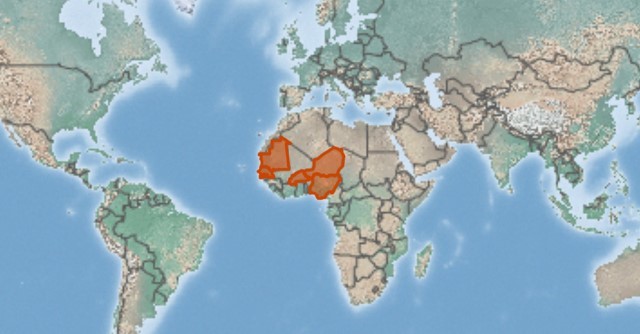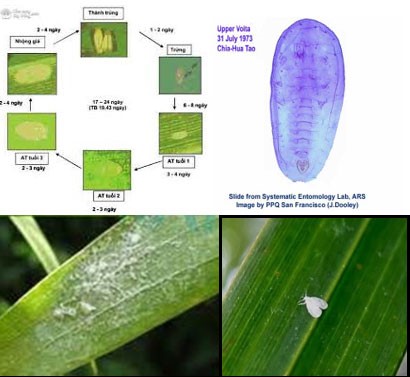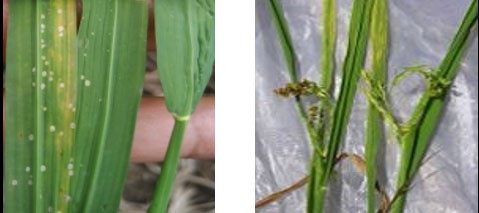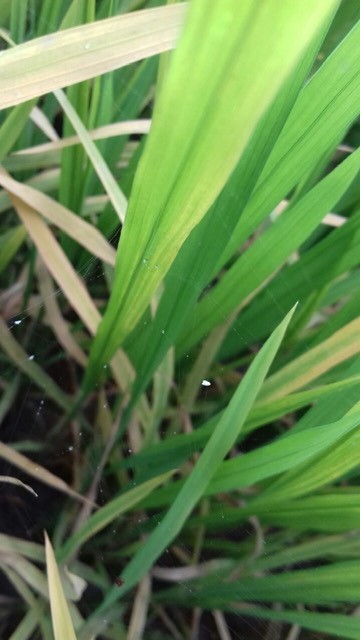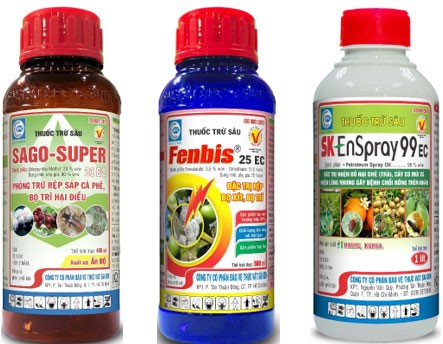|
RICE DAMAGING WHITEFLY (Aleurocybotus indicus)
21/06/2023
RICE DAMAGING WHITEFLY (Aleurocybotus indicus) 26/05/2022 Class: Insecta (insect). Order : Hemiptera (half-winged). Suborder: Sternorryncha. Family: Aleurodidae (Whitefly). Genus : Aleurocybotus. Species: Aleurocybotus indicus (Former name: Vasdavidius indicus) Whiteflywhitefly(Also: Whitefly ), due to a powdery coating on the body, the pest was first recorded on rice in 1966 in Santaram India and later in African countries: Senegal (1977), Nigeria, Niger, Mauritania, causing yield losses of up to 80%. In Vietnam, in the past, whiteflies were rarely found and caused damage on rice, only common on vegetables such as peppers, eggplants, melons, cucurbits, etc. In 2010, a large-scale pest was recorded in Long An, An Giang, Tay Ninh, infected area: 15,462 ha and now tends to spread in Mekong River Delta provinces and affect productivity.
Note: Rice whitefly, quite similar to guava whitefly (whiteflyAleurodicus dispersus/Hemiptera/Sternorrhyncha), cassavawhiteflywhitefly(Besimia tabaci/Hemiptera/Sternorrhyncha), but different Family: whitefly belongs to the Aleurodidae (whitefly), while guava and cassava whiteflies belonging to the white fly family. The durian jumping hopper (Allocaridara malayensis, belonging to the Psillid family ofwhiteflyjumping hopper), is uniformly winged (Homoptera). Damages Fields and rice affected by whiteflies whitefly causes damage by sucking leaf sap, causing leaves to turn yellow (larvae), rough leaf surface (mosaic), leaves twisted or contorted, leaf neck shrunk (adult), if damaging at the flowering stage , the flag leaf is blocked, twisted, sowhiteflythat opened panicle can not come out , if it comes out , the rice grain will also be shriveled. This symptom is similar to viral leaf curl dwarfism, but virus has not been detected in twisted leaves (Mekong River Delta Rice Institute). Damage mainly in the tillering stage, at first it is just a small yellow bunch, then it spreads along with the growth of the population, if not treated and met with favorable conditions (hot sun), will accumulate. density and cause severe damage in the flowering-bootingwhiteflystage. The varieties Jasmin 85, IR 50404… are susceptible to infection. According to research by the Mekong Delta Rice Institute, experiments on varieties OM 4900, IR 4625, IR 64, at the period of 30whiteflyday after sowing, infected 30-40 heads/tiller, affecting yield, if the infestation density is 60 heads/tiller, the yield will be reduced from 23 to 31%, the damage can be greater if whitefly damages the flowering-booting stage. Due to the flowering stage, the pistil of ricewhiteflyis white, so it is easy to confuse with whitefly, on the other hand, the symptoms of rice leaf yellowing at this stage are also easily confused with early ripening yellowing or leaf edge burn , wrong diagnosis will cause more severe damage. Because whiteflies have a relatively short life cycle (about 20-22 days), lay many eggs (100-200 eggs), eggs lay on the underside of leaves, spraying is difficult to contact, whiteflies develop and cause strong damage in hot weather. The long-term damage from tillering towhiteflyflowering-booting easily affect the yield, so it is necessary to visit the field regularly, detect it early and prevent it in timely manner Biological characteristics Life cycle – Eggs – whitefly Whitefly is hemimetabolic .The life cycle lasts about 17-24 days (shorter than BPH), including 3 stages: Egg - larva - adult. Larvae have four instars , 4-instar-larva is pseudopupa The adult has 2 pairs of white wings,whiteflyit is like a roof when perching, hiding in an airtight place, the average size: 0.98 mm/female and 0.83 mm/male, newly hatched, transparent adults. The wings are fragile, so they have weak flight power (half-wing / Hemiptera), then when the wings are dry, the body is covered with white powder, better flight power, when it is windy or disturbed, whiteflies fly out, whiteflies often hide and damage the underside of leaves. Female adults lay many eggs: 100-240 eggs, eggs are laid sporadically or in streaks on the underside of leaves near the main veins, concentrated near the leaf apex, lined up like fish scales, eggs are elongated, newly laid ones have white color, eggs are about to hatch turns brown, the survival rate (eggs-larvae) is about 70%. Unisexual reproduction , produce the next generation of 100 male adults (Mekong Delta River Rice Institute). Larvae are of thewhitefly3 instars. At the 1st instar, there is no pollen, moving near the leaf veins or around to suck, less moving because the legs are not yet developed, lasting 3-4 days. The 2nd instar : Molting, the body is covered with a thin layer of powder, clinging tightly to the leaf epidermis to suck, 2-3 days long. the 3 rd instar: the body changes little, does not move, is 2-3 days long, then molts to pseudopupaewhiteflythat have a hard shell, clinging to the leaf epidermis, after 2-4 days, the pupae fly out The suitable temperature for leaf whiteflieswhiteflyis 30 degrees Celsius, living and causing damage are common in the dry season, hot weather, peak period of Ba Chang drought (July-August) in the southern provinces. Eggs of whiteflies cling to the underside of leaves, are mosaic andwhiteflyear choking Secondary host Chloris barbata,whiteflyDactyloctenium aegyptium. Natural enemies Whitefly has many natural enemies, such as Parasitic Bees (Encarsia japonica, E.sophia, E.transversa...), predatory natural enemies such as 8-dot ladybug (Harmonia octomaculata)... Farming methods and whitefly population - Varieties of Jasmin 85, IR 50404, Đài thơm 8, RVT... are susceptible to infection. - Vareties OM 4218, IR 4625 sticky rice is less infected. - Transplanted rice has a lower population of whiteflies than seeded rice. - Thick sowing (150 - 250 kg/ha) gives higher numbers of whiteflies than sparse sowing (100 - 120 kg/ha). - The rice crop in the rainy season has a lower population of whiteflies than in the dry season, because rainwater reduces the population of whiteflies. - There was no relationship between water management in the field, weeds, straw and whiteflies population. Detection - Shake the foliage to see if whiteflies fly up or not - Observe the cobwebs in the field, see if there are whiteflies attached to the cobwebs or not - Observe the underside of rice leaves to see if there are whiteflies eggs laid along the leaf veins or not. - Pay attention to rice from tillering stage to flowering-booting stage, check the rice fields with yellow leaf symptoms to determine if it is due to yellow dwarf disease, leaf curling dwarfism, premature yellowing of leaves, leaf edge burn or whitefly. - Pay attention to the rice fields planted near the garden of guava, vegetables, melon, cassava ... - Regularly visit the fields affected by whiteflies in the previous crop, pay attention to the fields of excessive nitrogen fertilization, late nitrogen fertilization, dense fields, early spraying of pesticides. whiteflies attached to the cobwebs Chemical products - Research shows that chemical products based on Abamectin, Emamectin can control whiteflies 65-68%. Thewhiteflyproducts based on Pymetrozine (500g/kg) controlled 70.5 - 72.6% when observing 10 days after spraying (Mekong River Delta Rice Institute). In addition, other bases such as Imidacloprid, Acetamiprid also give good effect against whiteflies (CABI, IRRI). - It should be noted that because the body of whiteflies (adults) is covered with a layer of white powder, the eggs are covered in a hard, waterproof wax layer, therefore contact products are not as effective as those with systemic, deep penetration and fumigant effects and it is necessary to mix it with an adhesive or SK Enspray 99EC mineral oil, in addition, spraying with the right technique also helps to increase the effectiveness of prevention. Prevention and treatment Apply integrated measures, including: - Planting varieties resistant to whitefly, especially varieties with upright leaves. - Sowing at the same time, without sowing, planting thickly. - Fertilizer balance, reasonable, do not over-fertilize nitrogen, apply nitrogen late. - Visit the field regularly, pay attention to the tilleringwhitefly, flowering booting stages, especially when the field is often damaged. - The field is damaged early, can add Urea, DAP and Potassium fertilizers. - If the population of whiteflies is high in the flowering-booting stage (10-40 whiteflies per 30-50 rice bushes), which is likely to cause yield damage, one of the following products can be used: 1. Pymetrozine (+ Nitenpyram) base: Osago 80WG, Sagometro 50WG 2. Dinotefuranwhitefly(+ Imidaclorpid) base: Brimgold 200WP. 3. Abamectin/Emamectin base: Binhtox 3.8EC or Comda gold 5WG 4. Chlorpyrifos methyl base: Sago super 20EC 5. In case of immediate need to suppress the epidemic, use Fenbis 25EC (high effective against mealybugs andwhiteflyhas fumigant property ), Sherzol 205EC or Sec Saigon 25EC The above products need to be used alternately and should be combined with SK Enspray 99EC mineral oil to increase the effectiveness of prevention. When spraying, pay attention 1. Should spray close to the surface of the rice leaves to kill whiteflies adults, spray evenly on both sides of the leaves, and at the same time point the nozzle low below the foliage so that the whiteflies can easily hit the product and kill the eggs attached to the underside of the leaves. Pay attention not to spray when the rice is blooming, if necessary, spray in the afternoon. 2. Adjust the spray nozzle to fine particles and spray the recommended amount of water-product. 3. It is recommended to add SK Enspray 99EC mineral oil (mixed dose: 50 - 60 ml of mineral oil/25-liter-tank) or an adhesive (adhesive Sago) to dispel the powdery layer and prolong the retention on the leaves. 4. Should be sprayed early in the morning (6-9 hours) because whiteflies are still wet, fly slowly, do not spray when it is windy or about to rain. 5. Should be sprayed simultaneously to limit the spread of whiteflies, moving from one field to the next. 6. If the rice is about to flower, and is affected by whiteflies, it is possible to add fertilizer containing Urea, DAP, and Potassium. If the rice is just flowering, it can be sprayed with foliar fertilizer. References: 1. Plantwise Knowledge Bank, CABI, IRR82I 2. Mekong River Delta Rice Institute. 3. Doctoral Thesis of Vo Thi Bich Chi, Can Tho University of Agriculture, 2016. 4. Information of local sub-deparments.
|
To prevent, in addition to plowing and burying weed seeds, collecting weed stalks and stumps left after tilling the land to burn, not letting weeds produce seeds in production fields, etc., the use of chemical products is still a measure. optimal because of its ability to thoroughly kill weeds, reduce labor and take advantage of more time than manual weeding.
Miner has the scientific name Phyllocnistis citrella Staint., family Phyllocnistidae, order Lepidoptera. The miner occurs in many countries in the tropics and subtropics. The main host of the miner is the citrus family - Rutaceae. In addition, the miner also attacks mangosteen and some other plants.
Adult is a small planthopper, with a body 2-3 mm long, the whole body is ash gray, slightly greenish, the wings are opaque with many small brown spots.Eggs are oval, 0.3 mm long, have a pointed end and are attached directly to the leaf surface, leaf axils.
Green bugs specialize in the fruit of citrus groups (oranges, tangerines, lemons, grapefruits, kumquats...), some people call them orange bugs, or orange suckers. Their scientific name is Rhynchocoris poseidon or Rhynchocoris humeralis.
In Vietnam, yellow leaf curl disease is very common on papaya trees, especially the disease is often severe in areas of high and continuous planting, areas with hot and arid climates. The disease has significantly reduced the yield and quality of papaya. Gardens that are infected early when the plants are young may not yield. However, up to now, many gardeners still do not know the cause and how to fix it.
Spider mites are common pests on citrus trees, especially in hot and dry climates that are suitable for spiders to grow and cause severe damage.The group of harmful spiders is usually very small in size, unlike the natural enemy spiders.
This group includes species that are generally very small in size, causing damage by sucking plant sap (on leaves, fruits, branches, stems).
There are many species of mealybugs present on the group of Oranges,Tangerines,Grapefruits and Lemons (Citrus), which can be divided into 2 groups:
+ Group of sticky mealybugs with common varieties such as Lepidosaphes, Aonidiella, Coccus and Saissetia.
+ Group of flower mealybugs with common genera and species such as Pseudococcus, Planococcus and Icerya purchasi.
Dry branches and berries disease often appear to be common damage on coffee gardens during the rainy season. The disease causes death of branchs, dry fruit, severely affects the canopy structure and coffee yield if not paid attention to prevention.
Pink disease commonly causes diseases on rubber plantations in the rainy season, especially on garden from 4-8 years old. This year, rubber has to go through a period of severe drought, weakening the tree, so now in tnshe rainy season it is easy to get infected. Therefore, it is necessary to pay attention to good management to avoid affecting the garden.
In recent years, the area of citrus has been expanded because it is a fruit tree with high economic efficiency. However, in order to sell at a high price, not only in quality but consumers also require the external beauty of the fruit, so pest management on citrus is a matter of great concern to farmers. The hot season is a favorable condition for thrips to develop and cause damage, affecting the commercial value of fruit.
- Headquarters
- SAIGON PLANT PROTECTION JOINT STOCK COMPANY
- RQ 1, Nguyen Van Quy St., Tan Thuan Ward, HCM City
- Tax code: 0300632232
- Tel: (028) 38 733 295 - 38 732 077
- Fax: (028) 38 733 003 - 38 733 391
- Website: www.spchcmc.vn - Email: info@spchcmc.vn
- SAIGON PLANT PROTECTION COMPANY
- SAIGON PLANT PROTECTION JOINT STOCK ENTERPRISE
- Lot C1-C3 Hiep Phuoc Industrial Park, Hiep Phuoc Commune, HCM City
- Tel: (028) 3873 4089 - Fax: (028) 3873 4086
- Affiliated Unit
-
- Quick Links
- Home
- About us
- Career Opportunities


